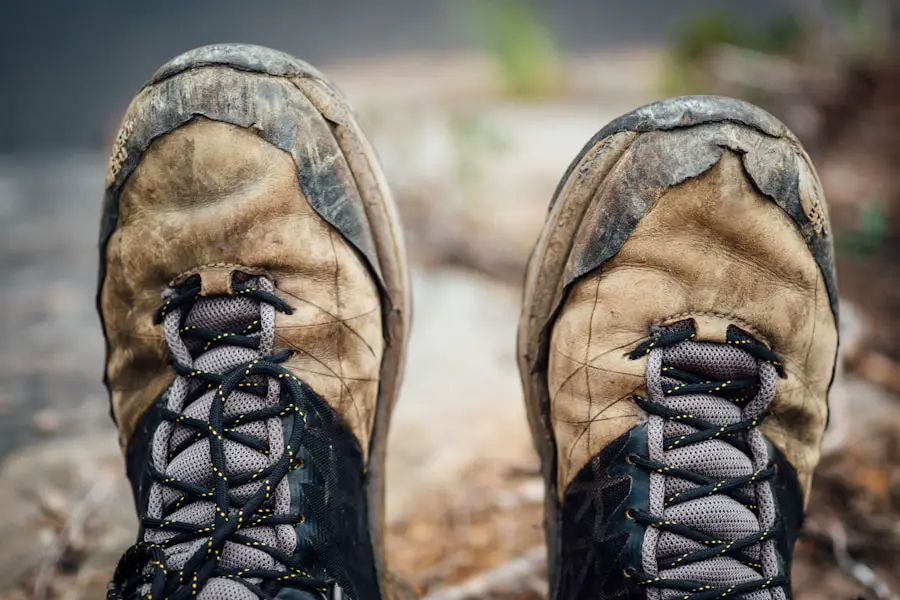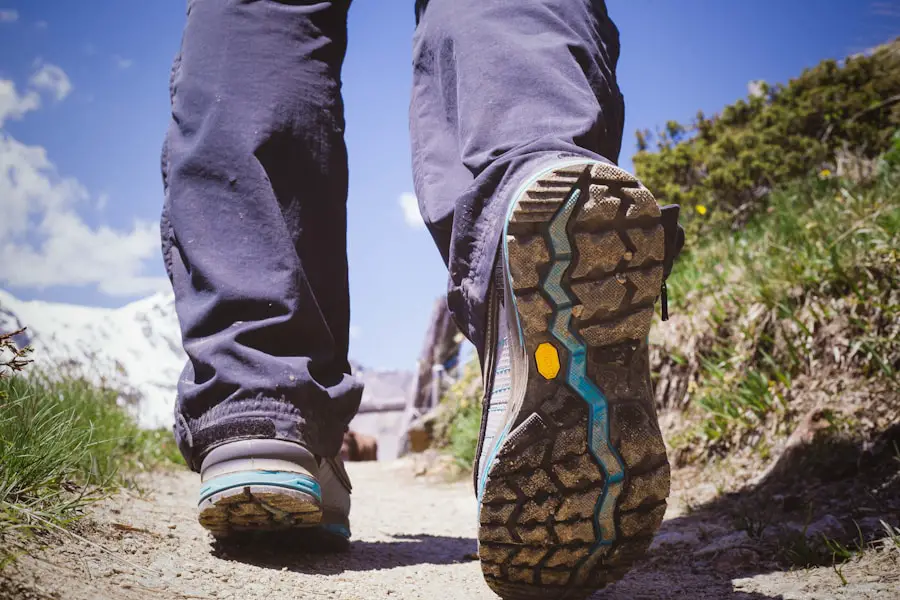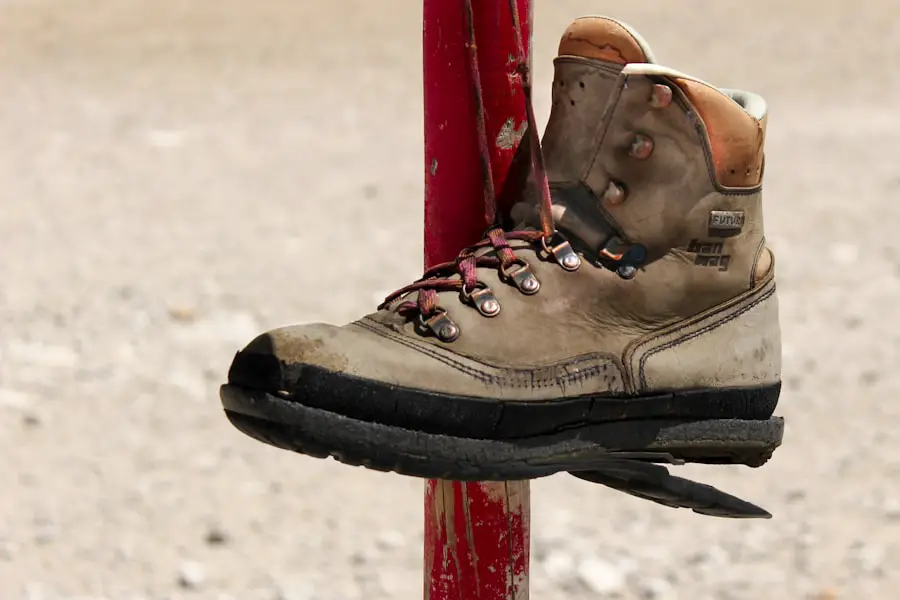Hiking boots are specialized footwear designed to provide support, protection, and comfort during outdoor activities, particularly hiking. These boots are engineered to withstand the rigors of uneven terrain, varying weather conditions, and the physical demands of long-distance walking. Typically constructed from durable materials such as leather, synthetic fabrics, and rubber, hiking boots are built to offer a combination of stability and flexibility.
The design often includes features like reinforced toe caps, waterproof membranes, and aggressive tread patterns to enhance grip and traction on slippery or rocky surfaces. The evolution of hiking boots has been influenced by advancements in technology and materials, leading to a wide variety of options available on the market today. From lightweight models suitable for day hikes to heavy-duty boots designed for multi-day treks, there is a boot tailored for every type of hiker.
The importance of selecting the right hiking boot cannot be overstated, as the wrong choice can lead to discomfort, blisters, and even injuries. As outdoor enthusiasts increasingly seek versatile footwear that can transition from trail to everyday use, the question arises: can hiking boots also serve effectively in work environments?
Key Takeaways
- Hiking boots are designed for outdoor activities such as hiking and trekking, providing support, stability, and protection for the feet and ankles.
- Hiking boots are different from work boots in terms of their design, materials, and intended use, with work boots being more focused on specific job requirements and safety standards.
- Using hiking boots for work can provide advantages such as comfort, traction, and durability, especially in outdoor or rugged work environments.
- However, there are also disadvantages to using hiking boots for work, including potential lack of specific safety features required for certain work environments and potential discomfort for long hours of standing or walking on hard surfaces.
- Hiking boots are suitable for work environments such as outdoor construction sites, landscaping, forestry, and agriculture, where the terrain and conditions are similar to hiking or trekking environments.
Differences Between Hiking Boots and Work Boots
While both hiking boots and work boots are designed for specific purposes, they cater to different needs and environments. Hiking boots prioritize features that enhance outdoor performance, such as lightweight construction, breathability, and flexibility. They often incorporate technologies like Gore-Tex for waterproofing and Vibram soles for superior traction on varied terrains.
The fit of hiking boots is typically snug around the heel and midfoot while allowing room for toe movement, which is essential for navigating uneven ground. In contrast, work boots are designed primarily for safety and durability in industrial or construction settings. They often feature steel or composite toe caps to protect against heavy falling objects, puncture-resistant soles, and slip-resistant treads to prevent accidents on slick surfaces.
Work boots may also include electrical hazard protection and insulation for cold environments. The fit tends to be more generous to accommodate thicker socks and provide comfort during long hours of standing or walking on hard surfaces. Understanding these fundamental differences is crucial when considering whether hiking boots can be a suitable alternative in a work setting.
Advantages of Using Hiking Boots for Work

One of the primary advantages of using hiking boots for work is their superior comfort during prolonged wear. Many hiking boots are designed with cushioning systems that absorb shock and reduce fatigue, making them ideal for jobs that require extended periods of standing or walking. The ergonomic design of these boots often includes features like padded collars and moisture-wicking linings that enhance overall comfort throughout the day.
Another significant benefit is the excellent traction provided by hiking boots. The outsoles are engineered with deep lugs that grip various surfaces effectively, which can be particularly advantageous in outdoor work environments or on uneven terrain. This feature not only enhances stability but also reduces the risk of slips and falls, a common concern in many workplaces.
Additionally, many hiking boots are constructed with waterproof materials, ensuring that feet remain dry in wet conditions—a crucial factor for those working outdoors or in environments where spills are common.
Disadvantages of Using Hiking Boots for Work
| Disadvantages | Description |
|---|---|
| Heavy Weight | Hiking boots are often heavier than traditional work boots, which can cause fatigue and discomfort during long work shifts. |
| Less Breathability | Hiking boots are designed for outdoor activities and may not provide the same level of breathability as work boots, leading to sweaty and uncomfortable feet. |
| Less Protection | Hiking boots may not offer the same level of protection as work boots, especially in industrial or construction settings where specific safety features are required. |
| Less Support | Hiking boots may not provide the same level of support for the ankles and arches as work boots, increasing the risk of injury during physically demanding work. |
Despite their advantages, there are notable disadvantages to using hiking boots in a work environment. One major concern is the lack of specific safety features found in traditional work boots. For instance, while some hiking boots may offer toe protection, they typically do not meet the stringent safety standards required in many industrial settings.
This absence of features like puncture-resistant soles or electrical hazard protection can pose significant risks in certain workplaces. Moreover, hiking boots may not provide the same level of support as specialized work boots designed for heavy-duty tasks. While they offer good ankle support for hiking, they may not be as robust as work boots that are specifically engineered to handle the demands of construction sites or other physically intensive jobs.
Additionally, the breathability of hiking boots can vary significantly; in hot environments, some models may not provide adequate ventilation compared to work boots designed with airflow in mind.
Types of Work Environments Suitable for Hiking Boots
Hiking boots can be particularly effective in various work environments where comfort and mobility are paramount. For instance, jobs that involve outdoor activities—such as landscaping, forestry, or environmental conservation—can benefit from the lightweight nature and traction of hiking boots. Workers in these fields often traverse uneven ground and encounter diverse weather conditions, making the supportive features of hiking boots advantageous.
Additionally, roles that require frequent movement between indoor and outdoor settings—such as park rangers or field researchers—can also find hiking boots suitable. The waterproof capabilities of many hiking models ensure that workers remain dry during unexpected rain showers or when traversing wet grass. Furthermore, jobs that involve light construction or maintenance tasks in less hazardous environments may also find hiking boots a practical choice due to their balance of comfort and functionality.
Types of Work Environments Unsuitable for Hiking Boots

Safety Standards in High-Risk Environments
High-risk industrial settings, such as manufacturing plants or construction sites, often require footwear that meets strict safety standards. In these environments, the absence of features like steel toe caps or puncture-resistant soles in most hiking boots can expose workers to significant hazards.
Chemical Resistance and Hazardous Materials
Jobs that require extensive exposure to chemicals or hazardous materials may also render hiking boots unsuitable. Many hiking boots lack the chemical resistance found in specialized work footwear designed for such conditions.
Heavy Machinery and Safety Certifications
Furthermore, environments where heavy machinery is operated may require footwear with specific safety certifications that hiking boots typically do not possess. In these cases, opting for traditional work boots is essential to ensure compliance with safety regulations and protect workers from potential injuries.
Tips for Choosing the Right Hiking Boots for Work
When considering hiking boots for work purposes, several factors should be taken into account to ensure an appropriate fit and functionality. First and foremost, it is crucial to assess the specific demands of the job. Understanding whether the work environment involves wet conditions, uneven terrain, or long hours on foot will help narrow down suitable options.
For instance, if waterproofing is essential due to frequent exposure to wet conditions, selecting a model with a reliable waterproof membrane is vital. Another important consideration is fit and comfort. It is advisable to try on multiple pairs while wearing the socks intended for use during work hours.
A proper fit should allow for some wiggle room in the toes while providing a snug feel around the heel to prevent blisters during extended wear. Additionally, evaluating the boot’s weight is essential; lighter models may be more comfortable for all-day wear but should still provide adequate support and protection.
Making the Decision to Use Hiking Boots for Work
The decision to use hiking boots for work ultimately hinges on a careful evaluation of both the job requirements and the specific features offered by various boot models. While hiking boots can provide comfort and traction in certain work environments, they may fall short in terms of safety features required in more hazardous settings. It is essential to weigh the advantages against potential drawbacks while considering individual needs and preferences.
Ultimately, understanding the unique characteristics of both hiking and work boots will empower individuals to make informed choices about their footwear. Whether opting for hiking boots or traditional work footwear, prioritizing comfort, safety, and functionality will lead to better performance on the job and contribute to overall well-being during long hours spent on one’s feet.
If you are considering using hiking boots for work, you may also be interested in finding the best hiking backpack for a multi-day trek. Check out this article on the best hiking backpack for multi-day trek to ensure you have the right gear for your outdoor adventures.
Love travel? Join Our Facebook Community For More Tips.
FAQs
What are hiking boots?
Hiking boots are sturdy, high-top footwear designed to provide support and protection for the feet and ankles during outdoor activities such as hiking, trekking, and mountaineering.
Are hiking boots suitable for work?
Hiking boots can be suitable for certain types of work, especially if the job involves outdoor activities, rough terrain, or heavy lifting. However, they may not be appropriate for all types of work environments.
What are the benefits of using hiking boots for work?
Hiking boots offer excellent ankle support, traction, and durability, making them suitable for work environments that involve walking on uneven surfaces, carrying heavy loads, or working outdoors in various weather conditions.
What types of work are hiking boots good for?
Hiking boots are well-suited for outdoor jobs such as landscaping, construction, forestry, and agriculture. They are also suitable for jobs that require walking on rough terrain or standing for long periods.
Are there any drawbacks to using hiking boots for work?
While hiking boots offer many benefits, they may not be the best choice for all work environments. They can be heavy and less flexible than other types of work boots, which may not be ideal for jobs that require a lot of movement or agility.
How should I choose the right hiking boots for work?
When selecting hiking boots for work, consider factors such as the type of terrain you will be working on, the level of ankle support needed, and the specific safety requirements of your job. It’s important to choose boots that are comfortable, durable, and provide adequate protection for your feet.
